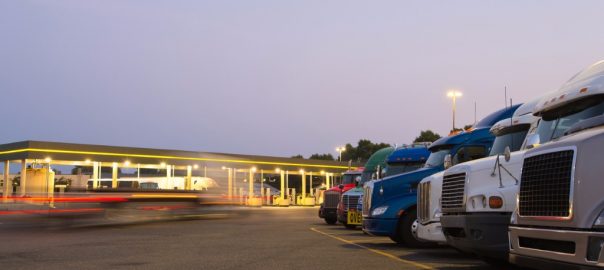Oil prices affect everyone. Especially truck drivers.  Owner-operators should pay very close attention to fuel changes since they have a direct impact on earning capabilities. Both high and low fuel prices have another big effect on our profits, and that is the impact they have on the economy in general.
Owner-operators should pay very close attention to fuel changes since they have a direct impact on earning capabilities. Both high and low fuel prices have another big effect on our profits, and that is the impact they have on the economy in general.
High vs. Low Fuel Prices
Low Fuel Prices – Low fuel prices have a major impact on our economy. Low oil prices can mean layoffs in the oil industry, and that means less freight to haul. Keep in mind, it doesn’t just affect those of us moving freight. If people are not working, they are not buying. That means less freight to move. For those that haul for the oil industry, this means they have trucks not moving at all. In the end, the rates drop.
However, for some, low oil prices are better, such as those with trucks that cannot achieve the fuel mileage set in the fuel surcharge. Or, those setting their rates on a hotshot basis without a fuel surcharge and buying their fuel.
High Fuel Prices – High oil prices work differently, but with the same result. Workers in the oil industry are earning and spending. High fuel surcharges earn good money, so it sounds like a win, right? Not everyone works in oil or trucking, and the cost of manufacturing goes up. The cost goes up as raw materials become more expensive and the cost of moving freight increases.
If you are achieving fuel mileage above the threshold for the fuel surcharge, the higher the prices become, the more of the surcharge you keep. If the prices are high enough, it just might work out where you get free fuel in your tank.
Another factor that is having a big impact on rates and freight volumes is the number of truck drivers available to operate.
Oil prices do not influence without the trucking industry. Well, we have no way to influence or change oil prices. However, we can manage to change the way the fluctuation affects us.
Controlling Fuel Costs
Most of the time we focus on fuel cost when often we need to re-focus on waste control. Owner operators should be watching what and where the waste is. Fuel wasting is the number one cause for concern.
Calculating fuel cost miles per gallon helps owner operators figured out where the waste is.
Calculate your miles per gallon (MPG) by tracking your mileage between fill-ups and dividing the total by the number of gallons you used for all trips individually. Since fuel economy constantly changes, with weather, loads, routes, traffic, terrain, road surfaces it is helpful to know your MPG per month, week and even load.
For good fuel economy, your truck must overcome three things: rolling resistance, air resistance, and gravity. Fortunately, your driving technique and other choices you make can address each of these.
Bad driving habits — such as driving too fast, above your engine’s fuel-efficiency sweet spot — are among the primary reasons for increased fuel consumption and reduced profit.
If you drive 130,000 miles per year and average 5.5 mpg vs. 6.5 mpg because you drive faster, you will spend $12,727 more on fuel. You gave yourself a 10-cent-per-mile pay cut.
Idle time – Idling requires about a gallon of fuel per hour, which can cost you about $160 per week at $4 per gallon if your truck idles eight hours a day.
Evaluate your idle-reduction need by keeping a detailed idle log. Write down every time you idle and why. Keep track of hours idled and sort them by reason, such as air-conditioning, heat, AC power, warming the engine, etc. Keep this log for three months and be disciplined in your records, you will be able to make good estimates for the other seasons.
Buy the Right Fuel. If you are in areas where farm vehicles are prevalent, it may be hard to find ultra-low-sulfur diesel fuel. Check labeling if you buy from any outlet that’s not clearly a truck stop.
Be Cautious with Biofuel. Biofuels tend to be expensive and produce lower fuel mileage.
Aerodynamic. There is plenty you can do to make your existing truck more aerodynamic.
- Snug the trailer tight to the tractor, which cuts down on wind resistance.
- Add features such as roof fairings, chassis fairings, cab extenders and aerodynamic mirrors.
- Mount air cleaners under the hood.
- Use all-position tires on the rear, and make sure they’re the same tread as the steer tires.
- Match sleeper package- when you’re pulling tanks or flatbeds, a flat-top sleeper is the most aerodynamic option.
- Keep your gross vehicle weight as light as possible; even if you make up for those weight savings with heavy loads, you’ll greatly improve your fuel economy per pound of cargo.
- For van or reefer trailers, side skirts and trailer tails have resulted in 1-mpg gains or more for some operators.
- Run wide-single tires instead of duals and cut down your mud flaps or invest in flaps that match the width of the tires.
Perform Regular Maintenance. Start a preventive maintenance routine; check often enough to catch low oil, a dirty air filter or an air compressor leak. Don’t use a higher-viscosity oil than you need. Also, check your current miles per gallon at each fill so you can determine the reason for fluctuation.
Maintain Tire Pressure. To reduce rolling resistance, check the air pressure in all tires and fill them up at least weekly to the manufacturer’s specifications.
Slow Down. Slowing acceleration is especially important running on hills or in the mountains because it helps reduce the effects of gravity. Rapid acceleration gets you an extra few seconds but creates premature wear on the engine, driveline, and tires – along with increasing your fuel costs. Hard and frequent braking converts precious fuel to wasted energy; you lose much of the fuel when you must speed up again.
Shift Wisely. Do not drive by engine sound but by revolutions per minute(RPM).
Cut Out-of-Route Miles. If you are like many owner-operators with 6 percent to 10 percent of your miles out of route – lost to detours, side trips and simple missed exits – you possibly could cut them 3 percent. Doing so would save an extra fuel, as well as on other variable costs such as tires and maintenance.


